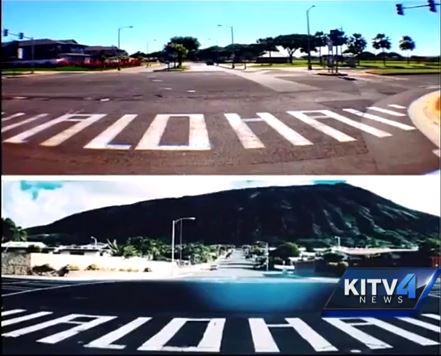Certain playful denizens have been adding paint lines to existing crosswalks in the Hawaii Kai and Kapolei areas of Hawaii to spell out the welcoming phrase, “Aloha.” First discovered this past Christmas, the alterations are considered by tourists and citizens to be, by and large, thoughtful touches — but for authorities, the painted lines amount to acts of vandalism.
The Aloha configuration will soon be removed. As Ross Sasamura of the Department of Facility Maintenance explained, according to Yahoo.com!, the crosswalk is “a national standard, and any deviation… creates the potential for drivers not recognizing that is a crosswalk.”
Some advocates of the mischievous design are opposed to the removal. Nathaniel Hood of Strong Towns, a nonprofit blog covering America’s towns, responded to the local upheaval over the crosswalk modifications, saying “Someone just wanted to make their neighborhood a better place and they just did it… Unfortunately, making your neighborhood a little more Aloha violates the Standard.”
Hood also argued that, contrary to the government’s safety concerns, the crosswalk design doesn’t pose any danger, writing that it is “within the original template, works within the lines, and was painted only on the less busy side street crosswalks.”
One resident, Ken Middleton, happens to be in favor of the design, but shared with local TV news channel KITV that “we started seeing people disrupting traffic, out in the middle of the street with cameras.” Still, he appreciates the underlying message: “Ah, slow down and enjoy a little Aloha.”
The cost to fix the crosswalk painting may reach $2,000, according to local TV news channel KHON, which reports that the city will have to purchase materials, assign a crew, create a traffic control plan, and ascertain that the area is safe for repair crews. The crosswalks will be amended either by wire brushing or “grinding into the roadway,” prior to re-painting the crosswalk.
(While a simple solution would seem to simply paint over the lines, Sasamura told KHON that “Crosswalk markings are actually something that’s fully vetted and specified to a national standard that we to comply with.”)
Hood reflected on the standard, saying, “To have a standard that is so inflexible is to say that we’ve perfected intersection crosswalks. We haven’t. Especially Hawaii which has some of the highest rates of pedestrian automobile-related deaths in the United States.”
Hawaii does in fact have some very real pedestrian safety issues. As reported by the Honolulu Civil Beat, more elderly pedestrians were killed here as of 2012 than anywhere else in the country. This year alone, a 94-year-old man, walking in a crosswalk, was killed after a driver ran a red light; a 68-year-old woman was also killed while crossing the street in a crosswalk, after an elderly driver hit her while making a left turn.
Part of the government’s concern is the “graffiti’s” impact on pedestrian safety. “It can pose a danger to pedestrians because people that are approaching it and driving in vehicles unfamiliar with that area may think it’s a marking on the road and not a crosswalk,” Sasamura told KOHN.
